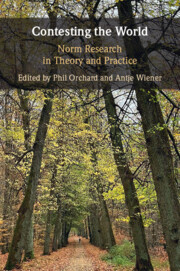Book contents
- Contesting the World
- Contesting the World
- Copyright page
- Contents
- Figures
- Tables
- Contributors
- Acknowledgements
- Abbreviations
- 1 Introduction
- Part I Norm Strength, Collisions, and Conflicts
- Part II Development of the Field
- Part III Meta-theorising, Linkages, and International Law
- Part IV Dimensions of Norm Contestation
- 12 Of Norms and Networks
- 13 Regulatory Contestation and the Creation of Transnational Legal Orders
- 14 Norms, Normativity, and Pragmatist Justification
- 15 Social in Practice, Contested in Principle
- References
- Index
12 - Of Norms and Networks
Theorising the Vital Link between Norm Contestation and Network Globalisation
from Part IV - Dimensions of Norm Contestation
Published online by Cambridge University Press: 01 November 2024
- Contesting the World
- Contesting the World
- Copyright page
- Contents
- Figures
- Tables
- Contributors
- Acknowledgements
- Abbreviations
- 1 Introduction
- Part I Norm Strength, Collisions, and Conflicts
- Part II Development of the Field
- Part III Meta-theorising, Linkages, and International Law
- Part IV Dimensions of Norm Contestation
- 12 Of Norms and Networks
- 13 Regulatory Contestation and the Creation of Transnational Legal Orders
- 14 Norms, Normativity, and Pragmatist Justification
- 15 Social in Practice, Contested in Principle
- References
- Index
Summary
The globalisation of advocacy and policy networks, including the dynamics of power that shape them, is integral to the emergence and evolution of norms. Yet the relationship between norms and networks remains undertheorised. How far and in what ways do changes in network structures affect the dynamism and diffusion of norms? Despite the cross-over empirically, and early scholarship on the role of advocacy networks in diffusing norms, the scholarship on international norms and that on transnational networks have subsequently developed on their own. This chapter explores the missing link between transnational networks and norm contestation by studying the spread and localisation of the ‘women, peace and security’ norm bundle. Networks do not merely serve to spread norms aka transmission belts. Rather, they are mechanisms of norm emergence, contestation, and transformation as well as diffusion. The transnational network spawned by UN Security Council resolution 1325 established a process to keep building the norm (bundle) and dialogue about it. Just as ‘norms’ are works in progress so too are the networks that support them. More attention needs to be focused on the changing nature of the agents and on the content of the evolving norms in discerning legitimacy or success of norms.
- Type
- Chapter
- Information
- Contesting the WorldNorm Research in Theory and Practice, pp. 199 - 218Publisher: Cambridge University PressPrint publication year: 2024

